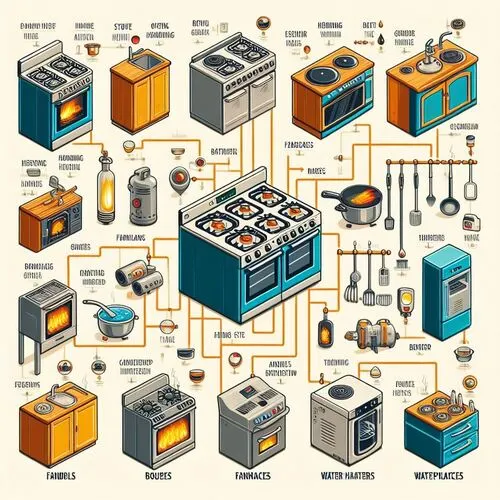Heat Sources: Understanding Nature and Harnessing Technology
I. Introduction
Heat sources play a pivotal role in our daily lives, fueling essential processes and technologies. This article delves into the intricate world of heat sources, exploring their diverse types, applications, and the global implications they carry.
What is a heat source?
A heat source is any substance or phenomenon that emits heat, warming its surroundings. These sources can be broadly categorized into natural and artificial, each with distinct characteristics and implications.
what are the Types of heat sources:
The Types of heat sources are two:
- Natural Heat Sources
- Artificial Heat Sources
what is the Importance of heat sources?
Heat sources are integral to various aspects of our lives, from basic necessities to advanced technological applications. Examining their impact on the environment is crucial for sustainable development.
II. what are the Natural Heat Sources?
The Natural Heat Sources are:
1. The Sun
The Sun is the primary natural heat source, emitting energy through nuclear fusion processes. Solar energy is harnessed for various purposes, including electricity generation and heating.
How the sun generates heat?
The Sun’s energy is produced through nuclear fusion, where hydrogen atoms fuse to form helium, releasing an immense amount of heat and light.
what is the Importance of solar energy?
- Sustainable energy source: Solar power is renewable and abundant, offering a clean alternative to traditional fossil fuels.
2. The Earth’s Interior
Beneath the Earth’s surface lies a wealth of heat sources, including geothermal energy generated by the planet’s internal heat.
- Geothermal energy: Tapping into Earth’s heat through geothermal power plants.
- Volcanic activity: Utilizing volcanic heat for energy production.
- Hot springs: Natural geothermal features with potential applications.
Other natural heat sources
- Chemical reactions: For example, heat generated during composting.
- Biological processes: Animal metabolism producing heat.
- Friction: Forest fires as a result of friction.
III. what are the Artificial Heat Sources?
Artificial heat sources are those created by humans to generate heat energy for various purposes. These sources are crucial for our modern lifestyle, providing warmth, comfort, and powering various processes. Here are some of the most common types of artificial heat sources:
1. Fuel-based heat sources
Fossil fuels (coal, oil, natural gas)
Fossil fuels are non-renewable energy sources formed from the fossilized remains of plants and animals that lived millions of years ago, like natural gas, coal and oil. They are primarily composed of hydrocarbons (hydrogen and carbon compounds) and can be burned for energy.
- Advantages: Widely available, high energy density.
- Disadvantages: Environmental pollution, finite resources.
Biomass (wood, biofuels)
Biomass, encompassing wood and biofuels, is a type of renewable energy source derived from organic materials. These materials come from recently living organisms, capturing the sun’s energy through photosynthesis. Biomass can be used directly for energy production, such as in wood-burning stoves, or converted into various biofuels like biodiesel, ethanol, and biogas.
- Advantages: Renewable, carbon-neutral when managed sustainably.
- Disadvantages: Deforestation, competition with food production.
2. Electrical heat sources
Electrical heat sources are those that convert electrical energy into heat. They are becoming increasingly popular due to their efficiency, cleanliness, and ease of use. Here are some of the most common types of electrical heat sources:
Resistance heating (e.g., space heaters)
Resistance heating is a simple and efficient way to convert electrical energy into heat. It works by passing an electric current through a high-resistance element, causing it to heat up. This heat is then transferred to its surroundings, warming the air or objects in contact with it.
- Advantages: Simple, efficient.
- Disadvantages: Energy-intensive, potentially unsafe.
Induction heating (e.g., cooktops)
Induction heating is an innovative cooking technology that utilizes electromagnetic induction to directly heat the cookware rather than relying on a traditional heating element. It involves passing an alternating current through a copper coil beneath the cooktop’s surface, creating a magnetic field. When magnetic cookware is placed on the surface, it induces electrical currents within the cookware, generating heat.
- Advantages: Precise control, energy-efficient.
- Disadvantages: Initial cost, limited to specific materials.
Other artificial heat sources
- Nuclear energy: Harnessing heat from nuclear reactions.
- Solar thermal energy: Concentrating sunlight for heat generation.
- Geothermal heat pumps: Utilizing Earth’s consistent temperature for heating and cooling.

IV. what are the Applications of Heat Sources?
The Applications of Heat Sources are:
1. Heating and cooling buildings
Traditional methods
- Furnaces, air conditioners: Conventional systems for temperature control.
Sustainable alternatives
- Heat pumps, solar thermal systems: Energy-efficient alternatives with lower environmental impact.
2. Industrial processes
- Manufacturing: Heat sources crucial in various industrial applications.
- Food processing: Maintaining hygiene and ensuring safety.
- Chemical reactions: Catalyst for chemical processes.
- Drying: Electric dryers and Gas dryers use heat to remove moisture from clothes, which is a crucial industrial process in various industries, such as textile manufacturing, laundry services, and food processing.
3. Transportation
- Internal combustion engines: Traditional heat sources in vehicles.
- Electric vehicles: Transitioning towards cleaner, electric-based heat sources.
Future trends
Exploring emerging technologies and sustainable practices in heat source applications.
V. what is the Impact of Heat Sources on the Environment?
The Impact of Heat Sources on the Environment are:
Climate change
- Greenhouse gas emissions: Fossil fuels contributing to the greenhouse effect.
- Global warming: Rising temperatures linked to heat source usage.
Air pollution
- Particulate matter: Emissions from combustion affecting air quality.
- Ozone depletion: Certain heat sources contributing to ozone layer depletion.
Resource depletion
- Fossil fuels: Finite resources impacting future availability.
- Land use: Deforestation and habitat loss linked to biomass energy.
VI. what are the Future of Heat Sources?
Renewable energy sources
- Solar energy, wind energy, geothermal energy, hydropower, biomass: A shift towards sustainable alternatives.
Energy efficiency
- Reducing energy consumption: Incorporating energy-efficient technologies.
- Smart technologies: Optimizing heat source usage through intelligent systems.
- Building design: Integrating passive heating and cooling strategies.
The transition to a sustainable energy future
Exploring challenges and opportunities in achieving a sustainable heat source landscape.
Policy and regulations
Governments and international bodies play a crucial role in shaping policies and regulations that promote the transition to cleaner energy sources. These policies and regulations aim to reduce greenhouse gas emissions, improve air quality, and enhance energy security. Read about are gas dryers being phased out article.
Public awareness
Educating the public on responsible heat source usage and environmental impact.

VII. Conclusion
In conclusion, the intricate world of heat sources encompasses a diverse range of natural and artificial elements that profoundly impact our lives. Recognizing the significance of these heat sources is pivotal as we strive to balance technological advancements with environmental responsibility.
Summary of Key Points
- Diversity of Heat Sources: From the immense power of the sun to the harnessing of geothermal energy, the variety of natural and artificial heat sources provides a rich tapestry for meeting our energy needs.
- Technological Advancements: Embracing technological advancements has allowed us to tap into new and sustainable ways of utilizing heat sources, promoting efficiency and reducing environmental impact.
- Environmental Responsibility: As we navigate the ever-evolving landscape of heat source utilization, it is crucial to emphasize the need for responsible and sustainable practices. This involves a conscientious approach to resource consumption and a commitment to minimizing negative environmental consequences.
- Importance of Diverse Sources: Recognizing the importance of diverse heat sources ensures resilience in the face of changing energy landscapes. It enables us to create a robust and adaptable energy infrastructure that can withstand challenges and uncertainties.
- Balancing Act: Achieving a delicate balance between meeting our energy demands and safeguarding the environment is essential. It requires careful consideration of the impact of various heat sources on the ecosystems and climate.
- Future Outlook: The future of heat sources holds both challenges and opportunities. Navigating these challenges requires a concerted effort to transition towards sustainable energy practices, harnessing the opportunities presented by renewable sources and innovative technologies.
Importance of Using Heat Sources Responsibly
As we stand at the crossroads of technological advancement and environmental stewardship, the importance of using heat sources responsibly cannot be overstated. Sustainable practices in heat source utilization are imperative to mitigate the impact on our planet.
The Future of Heat Sources and the Impact on Our Planet
The future of heat sources presents a unique opportunity to shape a sustainable energy landscape. By addressing challenges such as climate change, resource depletion, and pollution, we can pave the way for a more environmentally conscious and resilient future. Seizing these opportunities requires collaboration, innovation, and a commitment to building a world where heat sources contribute to the well-being of both humanity and the planet.
In essence, the journey towards a sustainable energy future is a shared responsibility. It requires individuals, industries, and governments to work in tandem, recognizing the delicate balance between technological progress and environmental preservation. Through responsible use and careful consideration, we can ensure that heat sources continue to serve as a source of warmth and progress without compromising the health of our planet.







